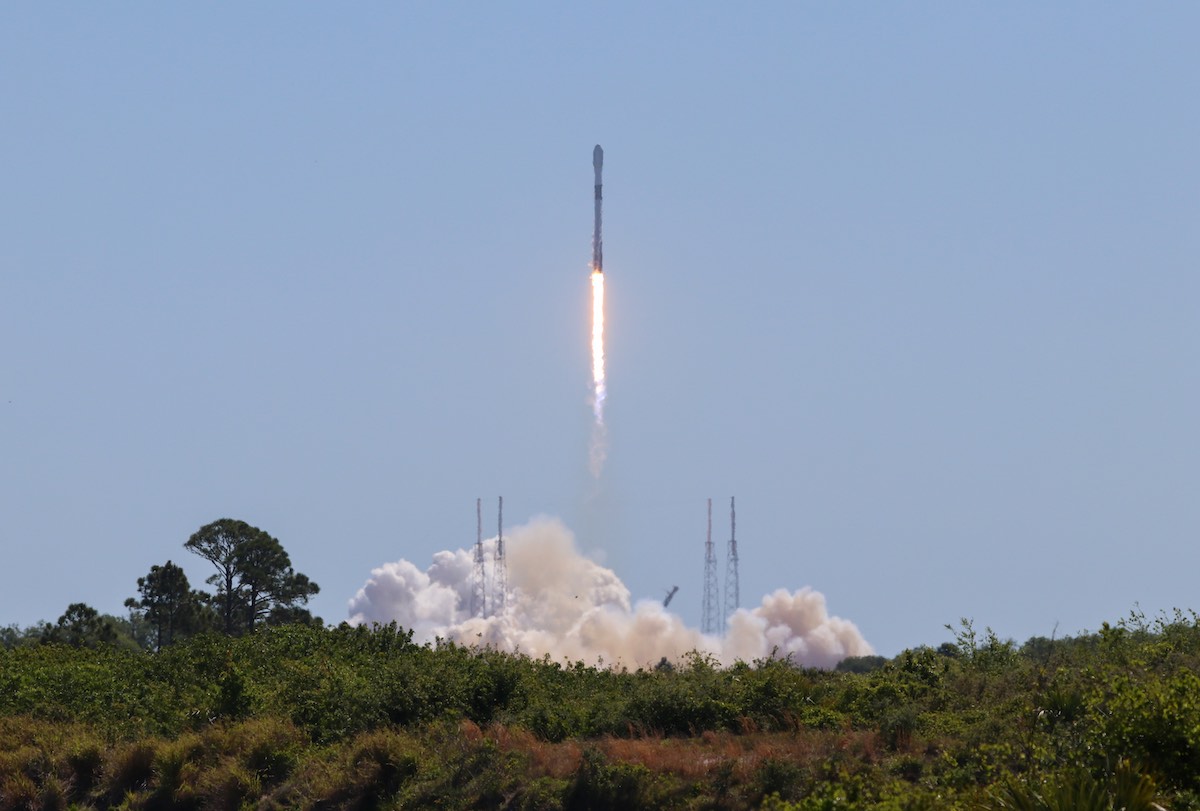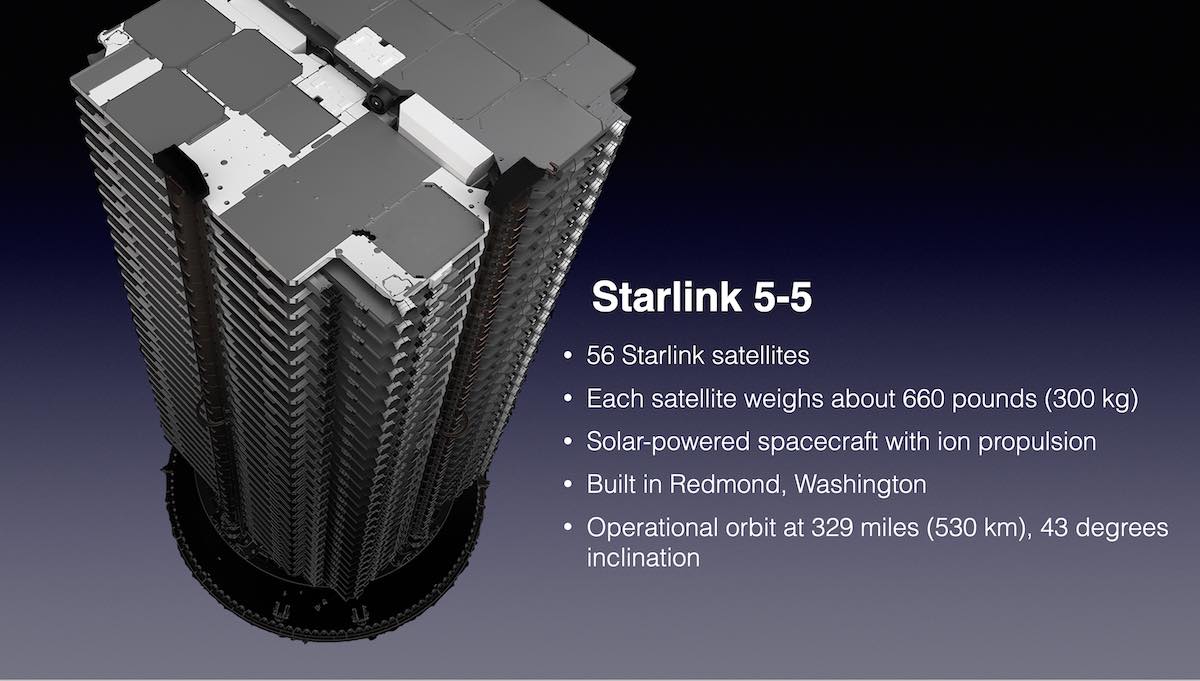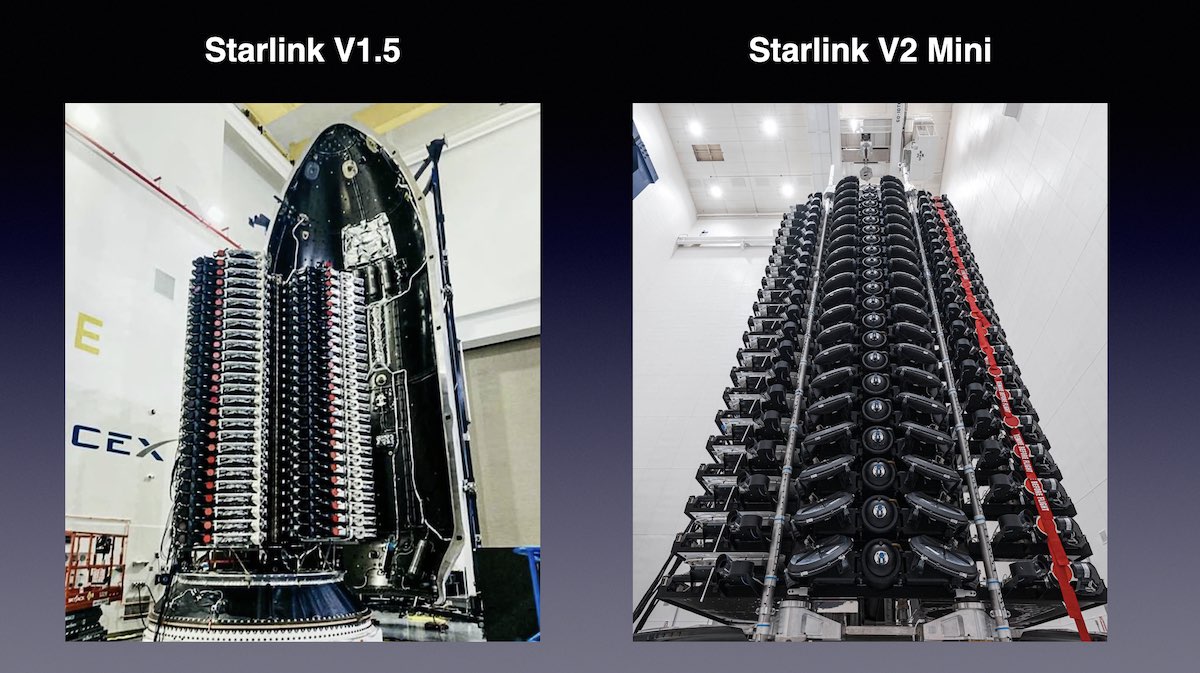The near-Earth asteroid 2023 DZ2 will pass within 107,500 miles (173,000 kilometers) of Earth today (March 25), and you can watch the flyby live online.
Space News & Blog Articles
Falcon 9 deploys 56 Starlink satellites on SpaceX’s 20th launch of the year
SpaceX’s Falcon 9 rocket heads downrange after liftoff Friday morning from Cape Canaveral. Credit: Michael Cain / Spaceflight Now / Coldlife Photography
SpaceX continued launching satellites for the Starlink internet network Friday, sending a Falcon 9 rocket aloft from Cape Canaveral with 56 more older-generation broadband spacecraft as ground teams troubleshoot problems with a batch of upgraded Starlinks launched last month.
The 56 satellites were packed on top of the 229-foot-tall (70-meter) Falcon 9 rocket for liftoff at 11:43:10 a.m. EDT (1543:10 UTC) Friday from pad 40 at Cape Canaveral Space Force Station. Riding 1.7 million pounds of ground-shaking thrust from nine kerosene-fueled Merlin main engines, the Falcon 9 accelerated faster than the speed of sound in about a minute as it raced through a sunny sky heading downrange toward the southeast from Cape Canaveral.
Following a now-familiar routine, first stage of the rocket shut down its nine engines two-and-a-half minutes after liftoff, then dropped away to begin an arc toward SpaceX’s landing platform, or drone ship, positioned about 410 miles (660 kilometers) southeast of Cape Canaveral, or northeast of the Bahamas. The rocket, numbered B1067 in SpaceX’s inventory, reignited a subset of its engines to slow down for re-entry and landing, then settled onto the deck of the floating platform about eight-and-a-half minutes into the mission.
The recovery team will bring the rocket, now a veteran of 10 flights to space, back to Cape Canaveral for refurbishment ahead of a future mission. A separate SpaceX team in the Atlantic was on station to retrieve the two halves of the rocket’s payload fairing, or nose cone, after they parachuted into the sea.
The Falcon 9’s second stage fired its single engine two times to inject the 56 Starlink satellites into an orbit about 200 miles (300 kilometers) above Earth, at an inclination of 43 degrees to the equator. SpaceX confirmed the successful deployment of the 56 spacecraft a little more than an hour into the mission.



See the moon turn blood red in this stunning lunar eclipse video
A new time lapse showcases the incredible view during a lunar eclipse, which will help us wait out the two-year drought until a new blood moon appears in our skies.
'Ring of fire' from US national parks: 7 great places to see the annular solar eclipse 2023
The annular solar eclipse 2023 will be visible in over a dozen U.S. national parks. Here are the best scenic spots to catch the spectacular 'ring of fire'.
Uranus grows a smoggy cap while Jupiter's Red Spot keeps shrinking, Hubble telescope reveals (photos)
New images of Uranus and Jupiter taken by the Hubble Space Telescopes reveal slow weather changes on these giant, distant planets.
Skywatchers enjoy a night of surprise auroras as strongest solar storm in years hits Earth (photos)
A surprise solar storm supercharged auroras across the U.S. and Europe last night (March 23), with sightings of the colorful displays reported from as far south as New Mexico and Arizona.
Rocket Lab recovers booster again after launch with BlackSky satellites
An Electron rocket lifts off Friday with two BlackSky Earth-imaging satellites. Credit: Rocket Lab
Two BlackSky optical Earth-imaging satellites rode an Electron launcher into orbit Friday from New Zealand, while the Electron’s first stage booster gently parachuted into the Pacific Ocean as engineers consider abandoning airborne rocket recovery in favor of ship-based retrieval and reuse.
Rocket Lab engineers will inspect and test components on the Electron booster stage once it returns to the company’s factory in Auckland to see how well the hardware weathered the rocket’s scorching-hot re-entry back through the atmosphere, and more crucially, how the booster withstood the corrosive effects of salt water after splashdown.
The 59-foot-tall (18-meter) carbon-fiber rocket took off from Rocket Lab’s privately-owned spaceport on the North Island of New Zealand at 5:14:56 a.m. EDT (0914:56 UTC; 10:14:56 p.m. local time).
Nine kerosene-fueled Rutherford main engines on the first stage fired two-and-a-half minutes before switching off, allowing the booster to drop away from the Electron’s second stage, which fired a single engine to continue the climb into orbit with two commercial optical remote sensing microsatellites for the U.S. company BlackSky.
The booster arced downrange and briefly climbed above the internationally-recognized boundary of space, then plunged back into the atmosphere over the Pacific Ocean.

Boeing Starliner's 1st astronaut mission delayed to May at the earliest
Boeing and NASA had been targeting April for Starliner's Crew Flight Test, but the astronaut mission will now launch after the private Ax-2 flight, which is targeted for early May.
Blue Origin says it finally knows what caused its New Shepard rocket launch to fail last year
The September 2022 in-flight failure of Blue Origin's New Shepard suborbital vehicle was caused by a problem with the vehicle's engine nozzle, the company announced on Friday (March 24).
Here's what the sky would look like if humans could see gamma rays (video)
A new NASA animation created using data from the Large Area Telescope aboard NASA's Fermi Gamma-ray Space Telescope shows the sky lit up by gamma-ray flashes.
NASA investigates veteran Mars orbiter to solve a missing fuel mystery
NASA engineers have solved the mystery of the Mars Odyssey orbiter's missing fuel, after estimates suggested the veteran spacecraft could be running on empty.
Strongest solar storm in nearly 6 years slams into Earth catching forecasters by surprise
A stealthy solar storm surprised forecasters, causing spaceflight delays and incredible aurora displays as far south as New Mexico.
ESA in miniature
Image: ESA in miniature
Hubble telescope captures galactic jellyfish with bright tendrils of star formation (photo)
A distant spiral galaxy boasts bright streams of star-forming gas dripping from its central disk like tentacles of a jellyfish in a new Hubble Space Telescope photo.
Best alien invasion movies of all time
Are we alone in the universe? Who knows, but cinema has toyed with that question many times. Here’s our list of the best alien invasion movies made so far.
When it comes to space, failure isn't just an option — it's a requirement
In spaceflight, we advance by learning from our mistakes — if, that is, we accept the learning we gain from those failures and apply it to our future endeavors.
Rocket Lab lifts off with 2 satellites onboard after unexpected solar storm delays launch
The strongest solar storm in six years delayed Rocket Lab's early morning launch on Friday, March 24, by 90 minutes, and space weather forecasters didn't see coming.
Want to see Uranus? The crescent moon points the way tonight (March 24)
The crescent moon will act as an excellent guide for skywatchers hoping to spot the distant solar system ice giant Uranus on Friday (March 24) with the celestial bodies making a closely separated in the sky.
Watch SpaceX launch 56 Starlink satellites, land rocket at sea today
SpaceX plans to launch 56 of its Starlink internet satellites and land a rocket at sea today (March 24), and you can watch the action live.

